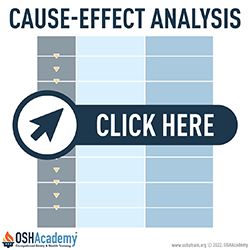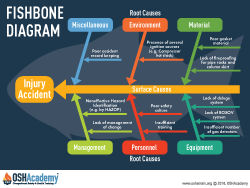Cause-Effect Analysis
One technique used in conducting root cause analysis when hazards are identified or when incidents/accidents occur is called Cause-Effect Analysis.
For every effect there is a cause. Starting with the accident, we analyze each event leading up to the accident to identify "effects." Then we attempt to uncover the cause for each event.
Every "effect" is the result of a "cause." It's important to understand that each effect is, at the same time, the cause for another effect. A single effect by itself can generate a completely new cause-effect branch. Click on the image to the right. It represents only one branch of many possible branches.
As you can see, the first set of questions get at the surface cause(s) related to an actual or potential accident. Once we know what directly caused the injury or illness, we begin to ask why to arrive at root causes. Each time a why question is asked, a deeper root cause is uncovered.
Something's Fishy Here
One of the primary tools in cause-effect analysis is the Fishbone Diagram or Cause and Effect Diagram. Basically, it's just a mind map using a different form.
The diagram illustrates this. The "Effect" describes the problem. Possible causes are listed under one of several categories that you determine. Generally, these categories might be people, materials, equipment, environment, methods, or procedures.
Knowledge Check Choose the best answer for the question.
6-4. When conducting any kind of analysis, it's important to remember that _____.
You forgot to answer the question!


